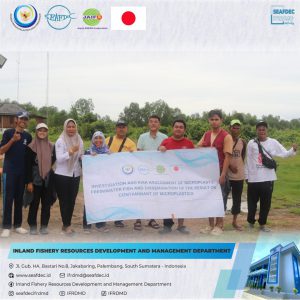Monitoring Marine Debris at the Musi River Estuary: Regional Collaboration for Cleaner Waters
 The Regional Collaborative Research and Capacity Building for Monitoring and Reduction of Marine Debris from Fisheries in Southeast Asia was conducted once again in the waters of Sungsang, Musi River Estuary, Banyuasin Regency, South Sumatra, Indonesia, from 17 to 20 November 2025. This activity is part of a continuous debris monitoring program in the Musi River aimed at understanding the conditions and dynamics of debris in the area. This project is supported through the Japan–ASEAN Integration Fund (JAIF) 2025.
The Regional Collaborative Research and Capacity Building for Monitoring and Reduction of Marine Debris from Fisheries in Southeast Asia was conducted once again in the waters of Sungsang, Musi River Estuary, Banyuasin Regency, South Sumatra, Indonesia, from 17 to 20 November 2025. This activity is part of a continuous debris monitoring program in the Musi River aimed at understanding the conditions and dynamics of debris in the area. This project is supported through the Japan–ASEAN Integration Fund (JAIF) 2025.
During this activity, the research team collected sediment, water, and fish samples, as well as drone imagery to map the surface conditions of the waters. The research also focused on examining the potential accumulation and transport of floating macroplastics using a hydrodynamic model. This comprehensive approach provides a clearer understanding of the movement patterns of plastic waste and helps identify areas with a high potential for debris accumulation.
The activity involved a cross-institutional team consisting of the Deputy Chief and staff of SEAFDEC/IFRDMD, three students from the Department of Marine Science, Faculty of Mathematics and Natural Sciences, Sriwijaya University, and fisheries extension workers from Research Institute for Inland Fisheries and Extension (BRPPUPP). This collaboration not only strengthened the data collection process but also offered valuable opportunities for students and extension workers to enhance their technical skills in the field.
Sampling was conducted at nine research stations covering strategic points along the estuary. This activity not only produced important scientific data but also strengthened regional cooperation in efforts to reduce marine debris. The results of this research are expected to serve as a basis for decision-making related to aquatic environmental management and conservation efforts in the Musi River and surrounding areas. Overall, this activity represents a concrete step toward achieving cleaner, healthier, and more sustainable waters.
